Yelp filed an antitrust lawsuit against Google for stifling competition and keeping searchers in its walled garden.
Almost a month after Google was declared to be a monopoly, Yelp brings forward legal complaints for using SERP features to keep traffic on its site and illegally scraping and using Yelp’s content.
In a CEO statement, Yelp lists interesting research papers about the impact of SERP features on organic traffic and implied revenue.
After dissecting the referenced papers and comparing them with my own findings from +7,000 results, I can confirm that the impact on traffic from most SERP features is negative.
Most companies have no idea about the traffic impact of SERP features and how to develop strategies that factor them in.
Click Drainer
SERP features are Google’s way of augmenting search results with potentially helpful direct answers.
You search for inspiration, and Google shows you images and video carousels. You search for products, and Google shows you stores near you that carry them or carousels of products you can buy online.
The benefit for companies is that they get a channel to customers with a stronger purchase intent. The risk is that Google sends out less traffic.
In some cases, SERP features can make a whole class of keywords redundant for SEO.
Yelp’s announcement cites an interesting paper from Germany by Fubel et al.: “Beyond Rankings: Exploring the Impact of SERP Features on Organic Click-through Rates,” which highlights the traffic impact of SERP features.
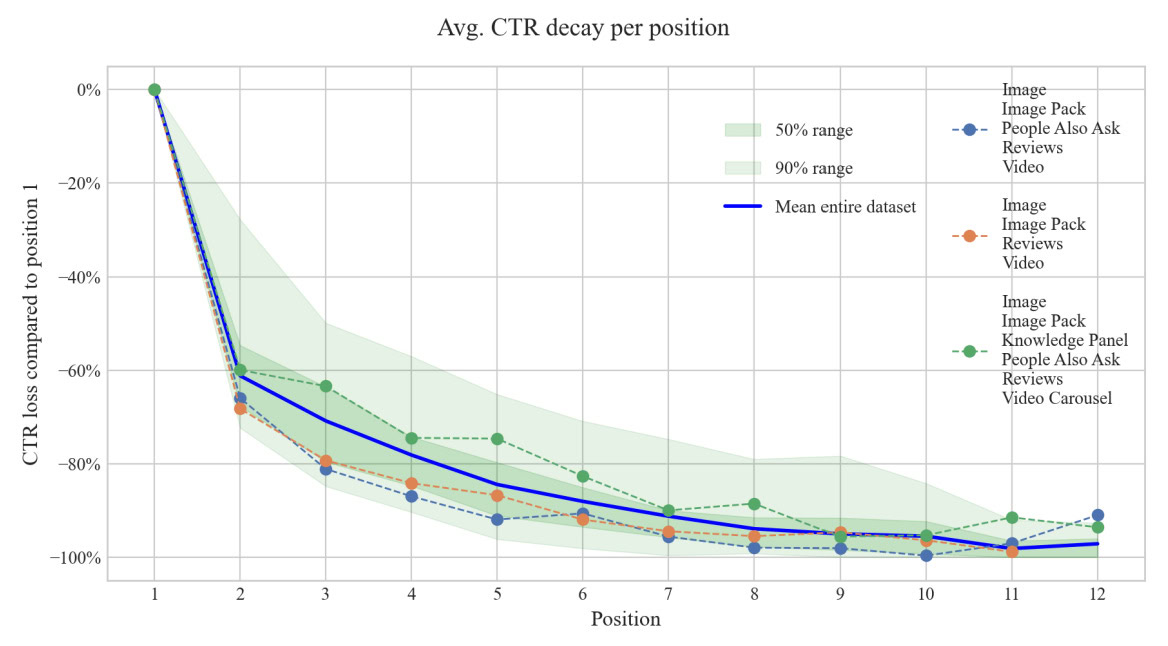 CTR by position based on whether certain SERP features are present or not. (Image Credit: Kevin Indig)
CTR by position based on whether certain SERP features are present or not. (Image Credit: Kevin Indig)The cliff notes:
Goal: The study sought to find out to what extent SERP features extend or inhibit clicks to organic results.
Method: The researchers compared predicted CTR with actual CTR for SERP features across six million clicks, 24 million impressions, 67,000 keywords, and 43 ecommerce stores from May to August 2022. To reduce noise, they filtered out any result below 20 impressions.
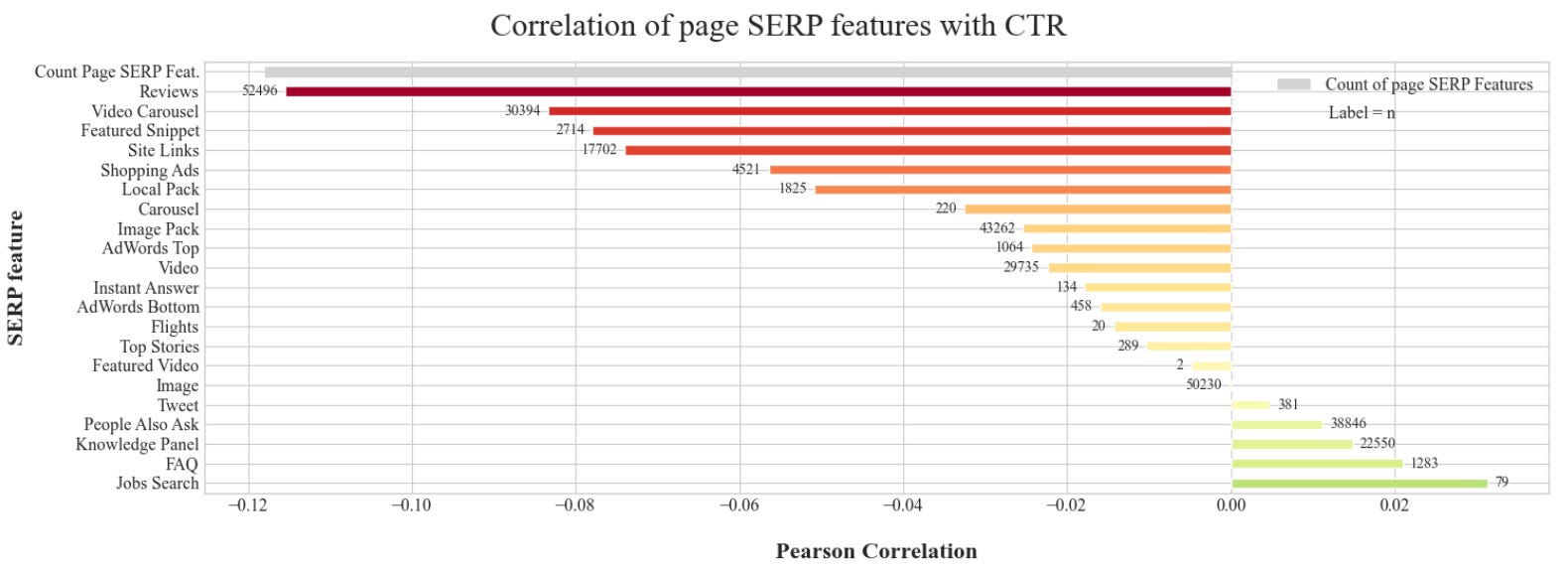 Image Credit: Kevin Indig
Image Credit: Kevin IndigResults: The presence of most SERP features hurts CTR. Most SERPs show four to six SERP features.
Some SERP features decrease clicks on all web results; others lower clicks on the first three results and raise them for the others. But most SERP features improve CTR for sites linked in them and reduce it for everyone else.
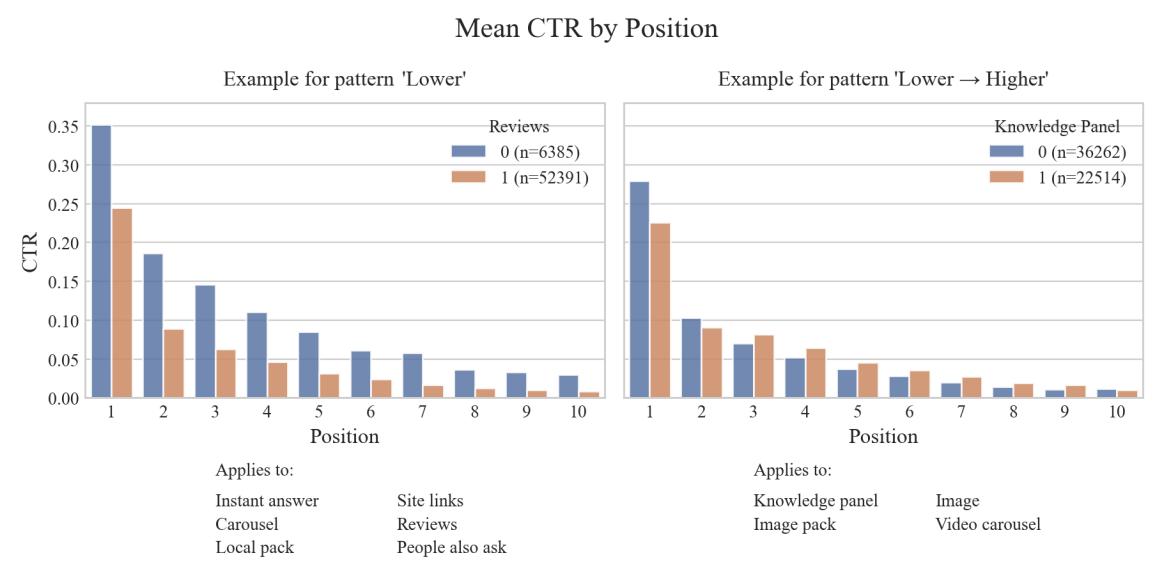 Click distribution when SERP features are present (1) and not (0) based on their position. (Image Credit: Kevin Indig)
Click distribution when SERP features are present (1) and not (0) based on their position. (Image Credit: Kevin Indig)It’s refreshing to see SERP features researched scientifically. One challenge of researching SERP features and Google results, in general, is that findings quickly become stale because Google makes so many changes.
SERP layouts can change daily, and Google constantly introduces new SERP features. One example is shopping, where Google introduced free listings and query refinements since the study came out (in 2023).
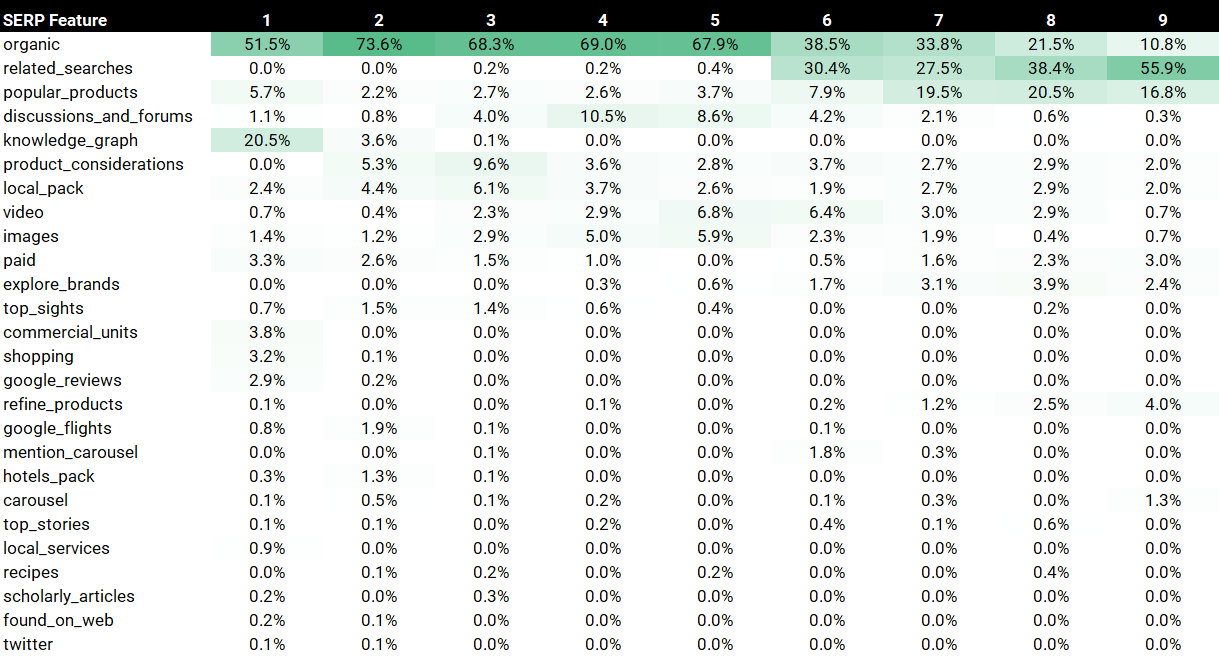 Some SERP features show up more often in specific positions. (Image Credit: Kevin Indig)
Some SERP features show up more often in specific positions. (Image Credit: Kevin Indig)To add to the paper, I conducted my own analysis of 1,000 random keywords across 7,869 results (US) and found overlapping results:
- Organic results appear most often in position 2 (73.6%) rather than 1 (51.5%).
- Knowledge graphs are the SERP feature most often appearing in position 1, followed by popular products (5.7%).
- Discussions & Forums hover mostly around positions 3 to 6.
- Video and image carousels often appear in positions 4 to 6.
- Related searches or popular products often appear in positions 6 to 9.
Knowledge graphs seem to be the most click-draining SERP feature, with an increased impact on mobile due to the screen real estate they occupy.
Related to findings in the German research paper, searches that return a knowledge graph are hard to monetize in nature because users are exploring a topic. As a result, Google keeps users on the platform until they express more transactional intent.
An example is the keyword “male hair growth,” where Google displays ads, organic listings, and a knowledge card.
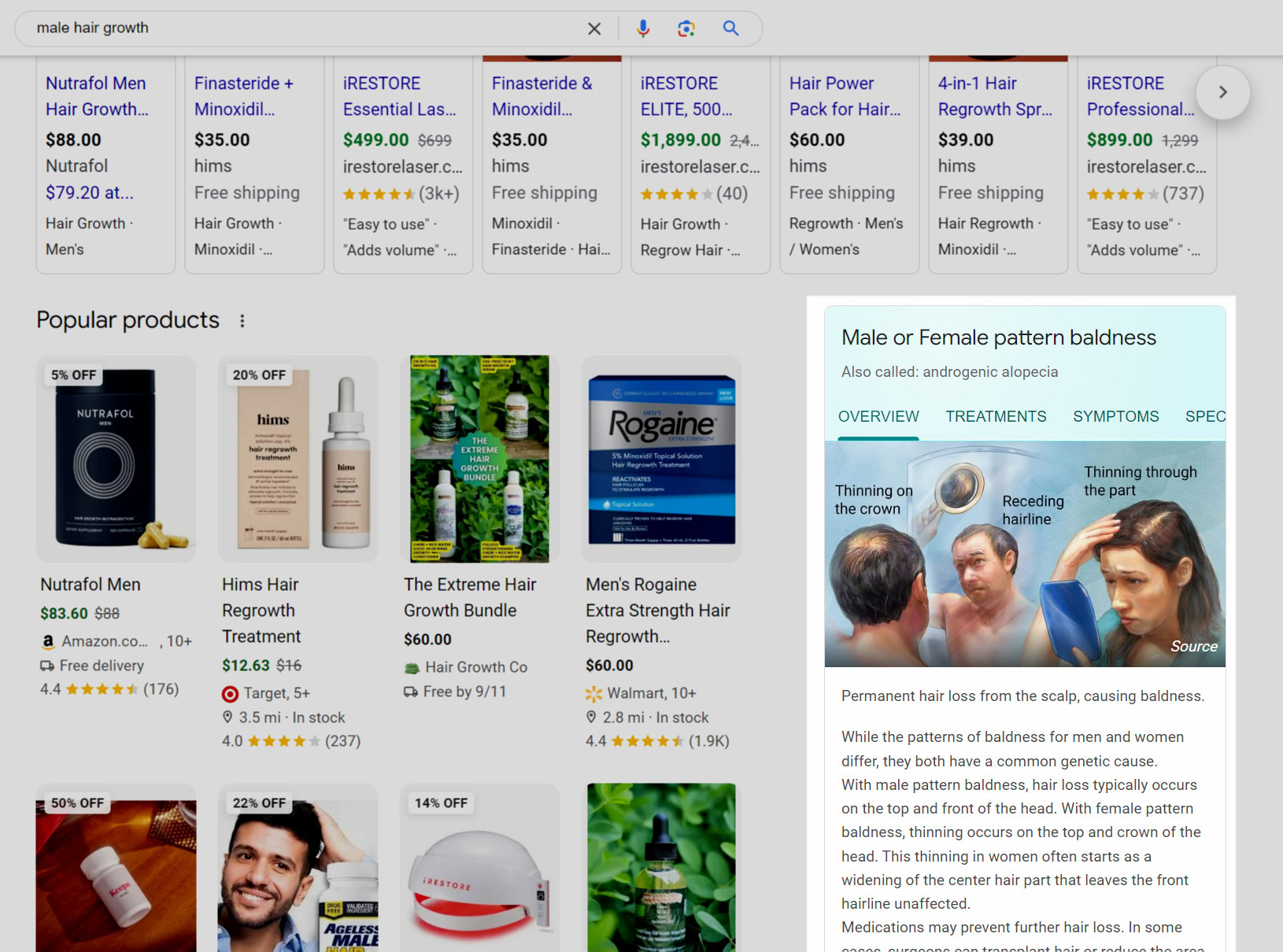 How much traffic do classic web results get when Google gives the answer away before organic results appear? (Image Credit: Kevin Indig)
How much traffic do classic web results get when Google gives the answer away before organic results appear? (Image Credit: Kevin Indig)Another example is the keyword “insurance policies,” where Google shows a Featured Snippet and a Knowledge Card.
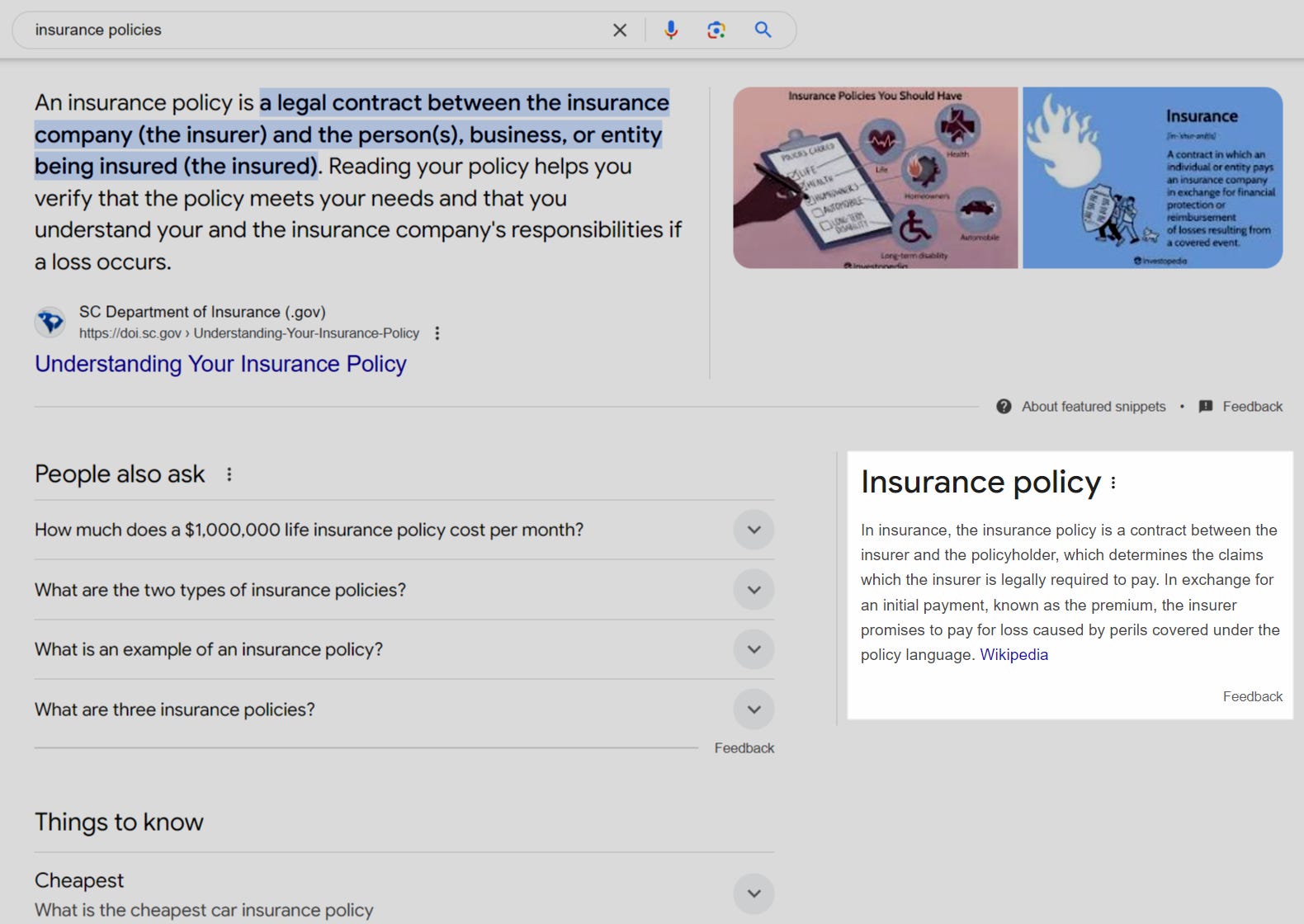 What do you need the Featured Snippet for when Google gives the answer itself? (Image Credit: Kevin Indig)
What do you need the Featured Snippet for when Google gives the answer itself? (Image Credit: Kevin Indig)The impact is much more severe on mobile, where Google gives the answer and makes many organic results redundant.
 Users see the Knowledge Card long before any organic results appear. (Image Credit: Kevin Indig)
Users see the Knowledge Card long before any organic results appear. (Image Credit: Kevin Indig)Strategically, SERP features cannot replace a No. 1 rank, but they can enhance traffic returns, as long as you’re in the top 10 results. The key to factoring SERP features into your SEO strategy is a) monitoring them and b) prioritizing keywords accordingly.
For monitoring, you need a solution (either a third-party tool or building your own solution with an API) that helps you understand which keywords show what kind of SERP feature over time.
Certain SERP features, like Knowledge Graphs and Local Packs, can significantly lower clicks. All the search volume in the world doesn’t matter if you don’t get the clicks.
For prioritization, you need to prioritize keywords according to the findings in the German research paper and my analysis: target image carousels, free shopping listings, and video carousels.
That said, one SERP feature bears a bigger risk than any other: AI Overviews. In a world where users get direct answers to complex questions from LLMs, there is less space for SERP features, which are most useful for shorter search queries.
Sundar Pichai: “People are using it to Search in entirely new ways, and asking new types of questions, longer and more complex queries, even searching with photos, and getting back the best the web has to offer.”
The impact of AI on search is also the real motivation for the Yelp lawsuit.
The Real Motivation
Source link : Searchenginejournal.com
